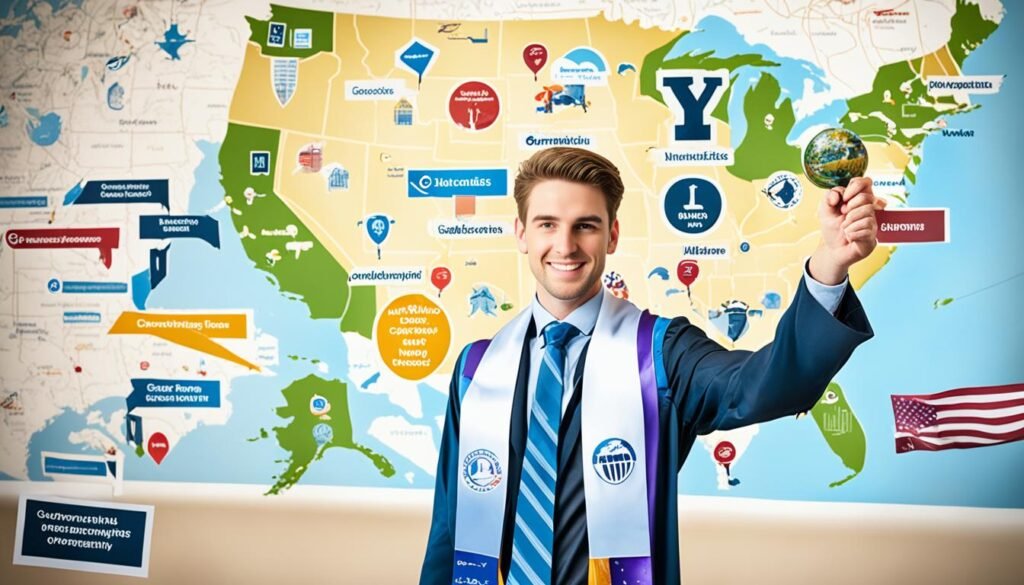Your academic journey in the United States doesn’t have to end with your graduation cap’s final toss into the air. The land of opportunity offers a tapestry of pathways for the ambitious graduate to transition smoothly from lecture halls into the vibrant workforce. But how easy is it to grasp the proverbial American Dream and start a career in the USA after your studies have concluded? The intricacies of employment in the USA post-graduation revolve around navigating various work visa options, each with its own set of rules and potential for personal career advancement.
Unlocking the door to your future American career may just be about how well you can align your post-study stream with the visa that fits just right. By understanding the options at your disposal, particularly the mechanisms that power an extension of your student visa, you ready yourself to walk the unique pathway leading to flourishing professional growth in the USA.
Key Takeaways
- Grasp the importance of the F-1 visa and its role in extending your employment options post-graduation.
- Discover the potential of Optional Practical Training (OPT) to catapult your career in the United States.
- Understand the critical steps needed for a successful transition to an H-1B visa for long-term career goals.
- Identify the critical criteria for eligibility along the various stages of securing employment in the USA.
- Recognize how education providers, such as The Continents States University, can bolster your career journey.
- Learn about the contingencies in play under emergent circumstances and special student relief provisions.
- Appreciate the significance of compliance with nonimmigrant student regulations to maintain your status.
Understanding Your Visa Options Post-Graduation
As you culminate your educational journey in the United States, it’s crucial to explore the pathways that allow you to extend your stay and gain valuable work experience. Navigating the intricacies of post-study visas is paramount for maintaining legal status while securing employment opportunities.

What is the F-1 Visa?
The F-1 visa acts as your entry ticket into the world of American education and, upon completion of your studies, it can serve as a bridge to professional growth. Approved educational institutions extend this visa to international students, which later opens up avenues for employment directly related to your major through Optional Practical Training (OPT).
Applying for an OPT Extension
A critical step post-graduation is to apply for an OPT extension, a provision allowing you an additional 12 months to work and apply your learned skills within the U.S. For those of you who pursued STEM degrees, you can access an extended timeline of 24 additional months, thus amplifying your practical experience and enhancing your job prospects.
The Path to an H-1B Visa
Looking beyond temporary training opportunities, the H-1B visa application is a gateway to long-term career prospects in specialty occupations. It’s a transformational step for many aiming to establish a robust professional footing, potentially granting you up to six years of work authorization in the United States.
- Reflects dedication to your professional career.
- Increase the prospects of securing specialized employment.
- Opens pathways for future endeavors, such as permanent residency.
Embracing these options facilitates a smoother transition from academic life to a dynamic workforce, ensuring that you retain your legal standing and continue to contribute to industry and innovation within the USA.
Navigating Optional Practical Training (OPT)
Stepping into the professional world in the United States as an international student is an exciting prospect, and the Optional Practical Training (OPT) program is a key pathway. Your journey to securing practical experience through OPT is structured with critical milestones to ensure that you meet all legal requirements while optimizing your chance for success. The pathway toward valid OPT eligibility involves understanding the timeline for applying and the critical requirements you need to satisfy. It’s not just about gaining work experience; it’s about doing so legally and beneficially. Let’s delve into how you can effectively navigate this process.

The Timeline for Applying for OPT
The timing of your OPT application is as crucial as the opportunity itself. Key deadlines include:
- Apply up to 90 days before your program end date, but no later than 60 days after.
- USCIS must receive your Employment Authorization Document (EAD) application before the end of your 60-day grace period post-graduation.
- Factor in USCIS processing times, which can vary, to avoid any disruption in your ability to work.
Remaining aware of these timelines is vital to maintain continuous employment eligibility and compliance with the F-1 visa regulations.
Critical Requirements for OPT Eligibility
Securing OPT eligibility is contingent upon meeting specific requirements. As you prepare your application, remember:
- You must be an F-1 student who has completed at least one full academic year in a USCIS-approved college, university, conservatory, or seminary.
- The job you seek must directly relate to your major area of study and support your career goals.
- You must maintain lawful F-1 status throughout your studies and OPT period.
These requirements are non-negotiable and failing to meet them could jeopardize your OPT prospects.
Navigating the EAD Application
The final hurdle in activating your OPT is successfully applying for your Employment Authorization Document (EAD). The paperwork might seem formidable, but with careful attention to detail, you can navigate it with confidence:
- Complete Form I-765 with accuracy, providing the evidence required by USCIS.
- Understand the fee structure and payment methods accepted by USCIS.
- Keep a copy of all documents for your records before sending your application.
Receiving your EAD is a green light to begin your OPT period and gain invaluable work experience in your field of study in the United States. Approach this process with the diligence it demands, and your post-graduation employment experience can begin with a strong foundation.
Maximizing Career Prospects with STEM OPT Extension
As a STEM graduate in the USA, you are at the forefront of career development and innovation. The STEM OPT Extension is a strategic tool that empowers you to apply your advanced knowledge to practical work experiences, amplifying your value in the competitive job market. With a focus on extending your practical training, you can effectively pave your way to not just jobs but impactful STEM careers in the dynamic landscape of the United States.

Eligibility Criteria for STEM Graduates
To qualify for the STEM OPT Extension, certain prerequisites must be met. It starts with a degree from an accredited institution that falls under the STEM disciplines—Science, Technology, Engineering, or Mathematics. But it doesn’t stop there; your job offer needs to be from an employer registered with E-Verify, ensuring a legitimate and valuable work opportunity that matches your academic prowess.
- Your major must be included in the Department of Homeland Security’s STEM-designated degree program list.
- You must have been granted initial OPT and currently be in your 12-month OPT period.
- Application for the 24-month OPT period must occur before your current OPT expiration.
How STEM OPT Benefits Your Career
Engaging in a STEM OPT Extension is not just a time extension for employment—it’s a career catalyst. The 24 additional months under the STEM OPT period allow you to gain significant experience and potentially contribute to groundbreaking projects and research. This is the time to build a network, prove your mettle, and set yourself up as a prime candidate for future roles, including eligibility sponsorship for an H-1B visa.
- Gain industry-specific skills that can only be acquired through practical experience.
- Develop a competitive edge with a longer duration of U.S. work experience.
- Establish a pathway to H-1B sponsorship and longer-term employment options.
- Collaborate with top-tier U.S. based companies and be part of pioneering STEM innovation.
The STEM OPT Extension is indeed a gateway to not just immediate job placements but also to broader STEM careers in the USA with long-term ambitions. Seize the opportunity to leverage these additional 24 months to springboard your professional journey in the land of innovation and opportunity.
The Role of The Continents States University in Your Career Journey
If you are considering where to pave the way for your professional future in the United States, The Continents States University stands out as an approved university in Missouri. Renowned for its engagement with students beyond the conventional classroom setting, this university prides itself on contributing positively to your post-academic life through tailored career support after graduation.
Study Programs at an Approved University
The Continents States University elevates the learning experience by offering innovative degree programs designed for the real world. Its curriculum is tailored to meet the demands of today’s employers, ensuring that you, as a graduate, are well-prepared to enter the competitive job market. The university’s status as a fully approved institution in Missouri provides you with the assurance of quality and recognition of your qualifications on a national scale.
Networking and Career Support Services
Emerging into the professional sphere requires more than just an academic degree—networking and ongoing career support are key. At The Continents States University, your journey from education into employment is supported by comprehensive services that connect you with industry leaders, alumni, and potential employers. These networking opportunities and personalized career guidance are designed to optimize your employment prospects and assist you in reaching your career milestones quickly and efficiently.
- Personalized career counseling to align your strengths with market needs
- Resume and cover letter workshops to sharpen your professional presentation
- Mentoring programs that pair you with experienced professionals in your field
- Job fairs and recruiting events exclusive to university students and alumni
Leverage the career support after graduation that The Continents States University provides as a stepping stone to a rewarding and successful career. By choosing this approved university in Missouri, you are not just earning a degree; you’re investing in a network and community that will propel you toward your professional objectives.

Transitioning to H-1B Status for Long-Term Employment
If your goal is to extend your professional journey in the United States beyond your post-OPT phase, obtaining H-1B status is a significant next step. This visa category not only opens doors for long-term employment in the USA but also serves as a pathway to more permanent work arrangements. Let’s discuss how you can seamlessly transition from OPT to H-1B status and solidify your footing in the American job market.
The Criteria for H-1B Visa Approval
To qualify for an H-1B visa, there are stringent criteria that must be met. First and foremost, your prospective role should require specialized knowledge typically associated with a higher education degree. Let us delve into what exactly makes you a prime candidate for H-1B sponsorship:
- Possession of a higher education degree or its equivalent is mandatory, demonstrating your specialized expertise in the field.
- A job offer in a specialty occupation from a U.S. employer who is ready to file a petition on your behalf.
- Sufficient evidence to prove that the job role cannot be easily filled by a U.S. worker due to the complexity or unique qualifications required.
- Prevailing wage compliance to ensure that you are paid fairly in comparison to others in similar positions in the same geographic area.
From OPT to H-1B: The Process
The leap from OPT to H-1B involves a timely and meticulously planned process, often synchronized with the H-1B visa lottery system’s schedule. Here are the critical steps to guide you through this transition:
- Advance planning is crucial: Start discussions with your employer about H-1B sponsorship well before your OPT expiration date.
- Prepare for the H-1B lottery, typically held at the beginning of April each year.
- Should your application be selected in the lottery, your employer will then be required to file a Form I-129 petition with USCIS on your behalf.
- Once the H-1B petition is approved, you can start working under H-1B status from October 1st of that year, provided it aligns with the cap-subject H-1B visa’s fiscal year calendar.
Your pursuit of H-1B status not only secures your professional future but also reflects your commitment to contributing to the American workforce. Embarking on your post-OPT career transition with clarity and preparation will pave the way for a successful and fulfilling career in the USA.
Paths to Permanent Residency in the USA
As you envision a future in the United States, understanding the various paths to permanent residency is key. Obtaining a green card signifies a pivotal step in cementing your long-term presence and career in the country. Let’s explore the essential steps and strategies that could lead you to secure permanent residency.
Understanding the Green Card Process
The journey to green card eligibility involves navigating a rigorous application process. The U.S. Citizenship and Immigration Services (USCIS) oversees this process, evaluating applications based on various criteria, including employment-based qualifications. For many international students and professionals, the US employment-based green card represents a pathway not only to career growth but also to establishing a permanent home in the USA.
Different Avenues to Obtain a Green Card
The pursuit of permanent residency can be realized through different avenues:
- Employment Sponsorship: Securing a job offer from a U.S. employer can lead to sponsorship for an employment-based green card.
- Family Ties: If you have close relatives who are U.S. citizens or permanent residents, they may sponsor you for residency.
- Investment: Entrepreneurs who make significant investments in U.S. businesses may apply for a green card under the EB-5 visa program.
- Diversity Lottery: The Diversity Immigrant Visa Program offers a limited number of green cards to citizens of countries with historically low rates of immigration to the U.S.
Evaluating these options with an eye on your long-term goals can significantly influence your prospects and decision-making as you consider the path that best suits your situation.
Emergent Circumstances and Special Student Relief
As an international student in the United States, you might face unforeseen challenges such as emergent circumstances that cause significant economic hardship. These situations are often distressing, but there is a pathway to alleviate your financial burden through USCIS employment authorization, specifically designed to aid those in such predicaments. Let’s delve into what this entails and how to navigate applying for this critical support.
What Constitutes Severe Economic Hardship?
Economic hardship refers to financial difficulty caused by unforeseen events beyond your control, impacting your ability to afford essentials and maintain your education. These emergent circumstances can range from sudden market fluctuations to the aftermath of natural disasters. To qualify for special relief, your situation must be assessed as severe, implicating the necessity for immediate employment to ensure your well-being and academic continuity.
How to Apply for Work Authorization Under Special Circumstances
When such hardships arise, it’s imperative to act swiftly. The United States Citizenship and Immigration Services (USCIS) permits you to apply for off-campus employment authorization. Here’s a simplified guide:
- Collect your evidence of economic hardship, including any relevant financial documents.
- Obtain an endorsement from your university’s International Student Office on your Form I-20.
- Complete Form I-765, Application for Employment Authorization, noting your circumstances.
- Submit the application within the USCIS specified timeframe to avoid delays.
Remember, each case is unique, and USCIS reviews applications on a case-by-case basis. By providing detailed information and adhering strictly to the USCIS guidelines, you enhance your chances of securing the employment authorization necessary to confront these emergent challenges head-on.
Compliance and Commitment: Your Responsibilities as a Nonimmigrant
As you navigate your educational journey in the United States, understanding the importance of nonimmigrant student compliance is vital. Your adherence to the regulations that govern your F-1 status is not just a legal requirement — it’s a testament to your dedication to your academic and professional aspirations. By maintaining F-1 status, you’re taking a step towards ensuring your time in the US is fruitful and uninterrupted.
Here are some key student responsibilities in the USA to keep in mind:
- Stay enrolled full-time and make satisfactory academic progress within your chosen program.
- Keep your English language proficiency at a level that supports your academic involvement and progress.
- Ensure you have the financial means to support your studies and living expenses throughout your stay.
- Seek authorization from the USCIS and a Designated School Official before engaging in any form of employment, whether it’s on-campus or off through programs like OPT.
Remember, being a nonimmigrant student in the USA is a commitment beyond academics. It extends to upholding the quality and integrity of your status in the eyes of institutions and government bodies alike. Your promise to return to your home country upon completion of your studies underlines the temporary nature of your stay and reflects your respect for the visa policies. Stay informed, stay compliant, and your American educational experience will stay on a course for success.
Conclusion
The pathway to start a career in the USA is laden with promising opportunities for you as an international student, yet it requires meticulous attention to the stringent immigration policies. As we’ve explored, avenues like OPT and H-1B visas are instrumental for those seeking post-graduation employment and entail a thorough compliance with their regulations. It’s clear that the journey from educational endeavors through to professional actualization is a multifaceted operation, demanding both dedication and a strategic approach.
Attending an institution such as The Continents States University not only opens doors to educational excellence but also bridges the gap to vocational accomplishments in the United States. Such universities are integral in providing you with essential support and guidance, leveraging your F-1 student opportunities to their utmost potential. Whether it’s extending your stay through training programs or transitioning to work visas, your proactive steps today lay the groundwork for your future endeavors in the American workforce.
In essence, your decision to further your education in the USA could be the cornerstone of a rewarding career, provided you navigate the journey with informed decisions and keen adherence to the visa guidelines set forth. Harnessing the full spectrum of student support channels and career services will aid in transitioning your scholarly achievements into a substantive and sustainable professional lifestyle. By understanding the landscape of post-graduation employment and integrating with the culture of enterprise in the USA, you are well on your path to carving out a niche in the dynamic and diverse American labor market.


